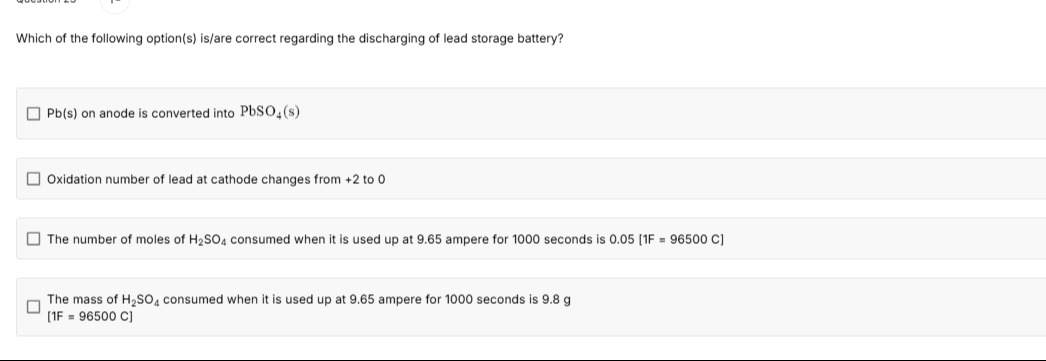Question
Question: Which of the following option(s) is/are correct regarding the discharging of lead storage battery? ...
Which of the following option(s) is/are correct regarding the discharging of lead storage battery?
□ Pb(s) on anode is converted into PbSO4(s)
□ Oxidation number of lead at cathode changes from +2 to 0
□ The number of moles of H2SO4 consumed when it is used up at 9.65 ampere for 1000 seconds is 0.05 [1F = 96500 C]
□ The mass of H2SO4 consumed when it is used up at 9.65 ampere for 1000 seconds is 9.8 g [1F = 96500 C]

Pb(s) on anode is converted into PbSO4(s)
Oxidation number of lead at cathode changes from +2 to 0
The number of moles of H2SO4 consumed when it is used up at 9.65 ampere for 1000 seconds is 0.05 [1F = 96500 C]
The mass of H2SO4 consumed when it is used up at 9.65 ampere for 1000 seconds is 9.8 g [1F = 96500 C]
Pb(s) on anode is converted into PbSO4(s), The mass of H2SO4 consumed when it is used up at 9.65 ampere for 1000 seconds is 9.8 g [1F = 96500 C]
Solution
The lead storage battery undergoes the following reactions during discharging:
1. Anode (Negative Electrode - Oxidation):
Lead metal (Pb) is oxidized to lead sulfate (PbSO4).
Pb(s)+SO42−(aq)→PbSO4(s)+2e−
The oxidation state of lead changes from 0 to +2.
2. Cathode (Positive Electrode - Reduction):
Lead dioxide (PbO2) is reduced to lead sulfate (PbSO4).
PbO2(s)+4H+(aq)+SO42−(aq)+2e−→PbSO4(s)+2H2O(l)
The oxidation state of lead in PbO2 is +4. The oxidation state of lead in PbSO4 is +2. So, the oxidation state of lead changes from +4 to +2.
3. Overall Reaction:
Combining the anode and cathode reactions:
Pb(s)+PbO2(s)+2H2SO4(aq)→2PbSO4(s)+2H2O(l)
During discharging, sulfuric acid (H2SO4) is consumed, and water is produced, leading to a decrease in the density of the electrolyte.
Now let's evaluate each option:
□ Pb(s) on anode is converted into PbSO4(s)
This statement is correct. As per the anode reaction, lead metal is oxidized to lead sulfate.
□ Oxidation number of lead at cathode changes from +2 to 0
This statement is incorrect. At the cathode, lead in PbO2 (oxidation state +4) is reduced to lead in PbSO4 (oxidation state +2). So, the oxidation number changes from +4 to +2.
□ The number of moles of H2SO4 consumed when it is used up at 9.65 ampere for 1000 seconds is 0.05 [1F = 96500 C]
First, calculate the total charge (Q) passed:
Q=I×t=9.65 A×1000 s=9650 C
Next, convert the charge to Faradays:
Number of Faradays (nF) = 1FQ=96500 C/F9650 C=0.1 F
From the overall reaction, Pb(s)+PbO2(s)+2H2SO4(aq)→2PbSO4(s)+2H2O(l), it is clear that 2 moles of electrons (2F) are transferred for every 2 moles of H2SO4 consumed.
Therefore, 1 mole of H2SO4 is consumed for every 1 Faraday of charge.
Since 0.1 F of charge is passed, 0.1 moles of H2SO4 are consumed.
This statement is incorrect as it states 0.05 moles.
□ The mass of H2SO4 consumed when it is used up at 9.65 ampere for 1000 seconds is 9.8 g [1F = 96500 C]
From the previous calculation, the number of moles of H2SO4 consumed is 0.1 mol.
The molar mass of H2SO4 is 2(1)+32+4(16)=2+32+64=98 g/mol.
Mass of H2SO4 consumed = moles × molar mass = 0.1 mol×98 g/mol=9.8 g.
This statement is correct.
